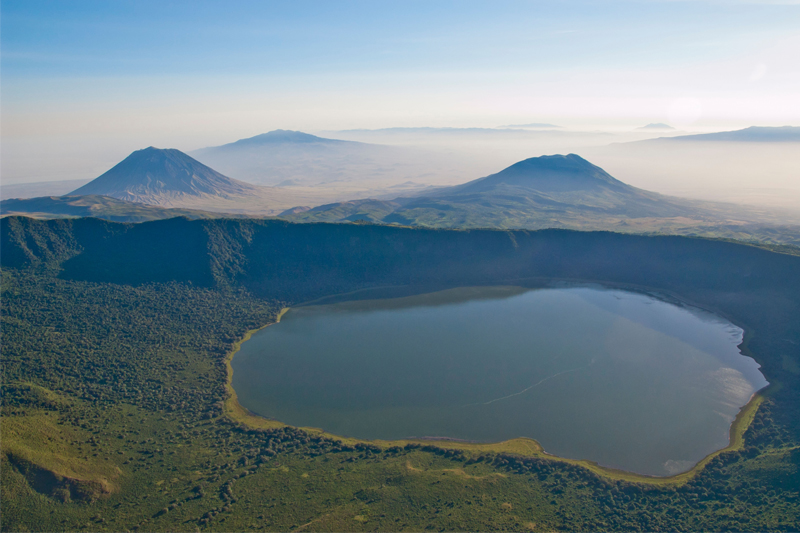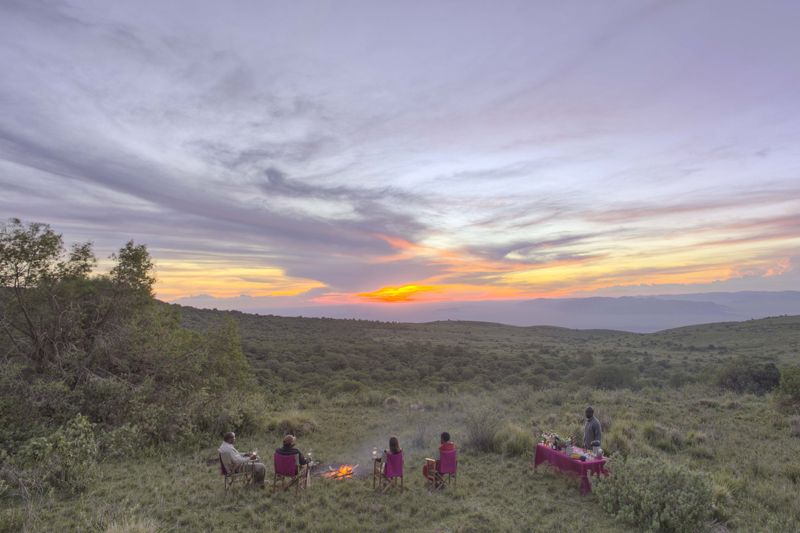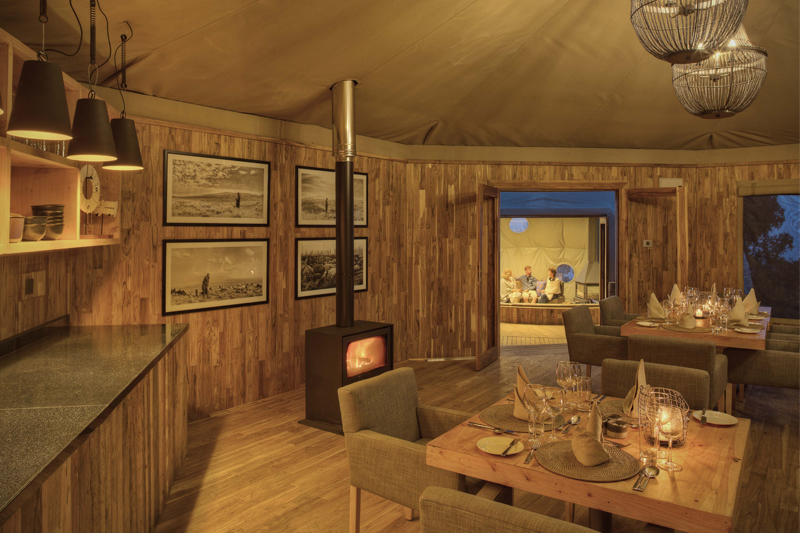The Highlands
The Highlands is an exclusive lodge located about an hour from the Ngorongoro Crater on the northern slopes of the extinct Ol Moti volcano in the Ngorongoro Highlands.
The Highlands is a unique property with great views, interesting and very comfortable accommodation, good service and a friendly atmosphere. The property has a great feel and is well run. Being located an hour from the Lemala gate of the Ngorongoro Crater means that it is not the closest lodge to the crater for game viewing, but they offer the chance to set off early if desired and enjoy a really good picnic lunch on the crater floor! The location of The Highlands is however very exclusive and is perfect for visiting local villages and for exploring on foot, with options to climb Ol Moti and to descend into Empakai Crater. We view this as a real bonus given the busy/driving nature of most Northern Tanzania safaris. The local area is home to the Maasai tribe and is far more remote and rural than the busier Karatu region where most other Ngorongoro Highlands accommodation is located. Guests who have an interest in walking and culture, as well enjoying remote scenery, will benefit most from visiting The Highlands.
Rooms
The Highlands is an exclusive retreat accommodating around 21 guests in eight domed suites which are built from a combination of wood and canvas, with uniquely designed plastic dome windows. All of the domes have en suite plumbed facilities, including a toilet, shower and double vanity, a wrap-around balcony, a couple of relaxing chairs and a wood-burning stove. Several of the suites have a sleeping area with a third bed on a raised mezzanine. One of suites is designed to accommodate families with a second smaller suite connected to the main suite via a covered walkway. The smaller suite has twin beds and an en suite shower room. Another of the suites is ideal for honeymooners with an elevated deck and outdoor hot tub.
Central Areas
The central areas are built in a similar style along the hillside and house the dining, bar and lounge areas which are linked together by walkways and steps.
Facilities
Wi-Fi – Yes
Power for Charging – Yes
Swimming Pool – No
Habitat & Wildlife
The Ngorongoro Highlands sit on the western edge of the Great Rift Valley as it curves south-westwards from the desolate Lake Natron past Lake Manyara to the remote Lake Eyasi. These highlands are the remnants of an ancient chain of volcanoes, most of which are now entirely dormant. The only active volcano here now is Oldoinyo L’Engai, to the north of the Ngorongoro itself and at the southern end of Lake Natron. The upper highlands are home to Maasai pastoralists who live a traditional lifestyle, co-existing with the resident game.
The Ngorongoro Crater lies within the 8,000 sq. km Ngorongoro Conservation Area and is one of the natural scenic wonders of the world. The magnificent crater is a ‘caldera’ or collapsed crater which is 16-19 km in diameter with an unbroken rim. The altitude of the crater rim is around 2,250 metres, with the crater floor some 650 metres below.
The crater contains a large animal population throughout the year, including lion, leopard, cheetah (sporadic), elephant, black rhino, buffalo, hippo, hyaena, eland, zebra, giraffe, gazelle, ostrich, golden jackal, serval, African wild cat and wildebeest (wildebeest calving occurs around January). The birdlife is prolific too, with flocks of flamingos Lake Magadi.
The Crater floor has a number of habitats – the southern side includes a number of ‘crater lakes’ and an extensive acacia woodland known as Lerai Forest, whereas to the northern side the habitat is one of open grassland. Thick montane forests cover the steep sides and rim.
Perhaps because the Ngorongoro Crater is so special, it receives a very high number of visitors and the crater floor can be subject to overcrowding particularly in the busier tourist months from July to September and at Christmas/New Year. No off-road driving is allowed and the crater is only accessible during daylight hours. There are a number of tourist lodges along the crater rim and in the surrounding highlands.
Beyond the Ngorongoro Crater it is possible to hike down into Empakai Crater, or to the top of Ol Moti Volcano. Whilst you can see limited wildlife in these areas, and throughout the highlands in general, it is necessary to go inside the Ngorongoro Crater for genuine big-game game viewing.
In the north-east Ol Donyo Lengai can be climbed, but it is a challenging ascent. At the foot of Ol Donyo Lengai is the harsh landscape of Lake Natron, an area that is well worth exploring if you enjoy remote, wild places. Lesser flamingoes breed around the lakeshore.
Activities
Activities from The Highlands include game drives into Ngorongoro Crater, which is a one hour drive away, guided walks up nearby Ol Moti Volcano (shortish climb) and/or down into the stunning Empakai Crater, and scenic drives through the highlands with visits to local Maasai villages.
Seasons
The Highlands is open all year round, though it is best to visit between December and March, or from June to October.
The Highlands accepts children from 5 years and is suitable for families with their family suite. The family suite comprises of a standard double suite which is connected to a second smaller suite via a covered walkway. The smaller suite has twin beds and an en suite shower room specifically with children in mind. Although the driving and walking options may not be very suitable for young children, it is possible to choose a more relaxed schedule and visiting local villages would be eye-opening for children of all ages.
Staying at any of Asilia properties, owners of The Highlands, sees guests automatically contributing to community and conservation projects through their guest conservation charge. By staying at The Highlands guests are also supporting their in-house training schemes and responsible tourism efforts.
Asilia’s vision in East Africa is for both the local people and nature to benefit from crucial wilderness areas thriving. They work with local communities and offer primary, secondary and tertiary educational scholarships. Twende Porini, meaning ‘let’s go to the bush’, is a project which takes a group of children from their villages close to the areas in which Asilia operates, to one of their camps for several days. Whilst at the camp the children are mentored by Asilia guides and staff as well as local school teachers and engage in a range of activities from lectures to game drives in order to assist their understanding for the need for conservation in the wild areas close to their communities.
Sustainability efforts in Asilia’s camps include banning the use of cling film in their kitchens, using biodegradable lunch packs and providing guests with reusable bottles to reduce plastic water bottle waste.
AsiliaGiving is an online donation platform for their UK and US charities with total annual donations increasing significantly. The projects which AsiliaGiving support are both human and wildlife focussed.
The Highlands, specifically, supports their local Maasai community by offering their guests the chance to visit the local bomas and engage in the culture by joining in activities such as milking the cows or collecting firewood.































